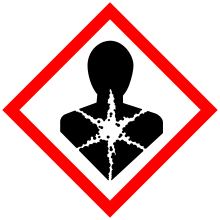Isopentane
 | |
| | |
 | |
| Names | |
|---|---|
| Preferred IUPAC name
2-Methylbutane[1] | |
| Other names
Isopentane (no longer recommended[1]) | |
| Identifiers | |
| 78-78-4 | |
| 3D model (Jmol) | Interactive image |
| 1730723 | |
| ChEBI | CHEBI:30362 |
| ChemSpider | 6308 |
| ECHA InfoCard | 100.001.039 |
| EC Number | 201-142-8 |
| 49318 | |
| MeSH | isopentane |
| PubChem | 6556 |
| RTECS number | EK4430000 |
| UNII | ZH67814I0O |
| UN number | 1265 |
| |
| |
| Properties | |
| C5H12 | |
| Molar mass | 72.15 g·mol−1 |
| Appearance | Colorless liquid |
| Odor | Odorless |
| Density | 616 mg mL−1[2] |
| Melting point | −161 to −159 °C; −258 to −254 °F; 112 to 114 K |
| Boiling point | 27.8 to 28.2 °C; 81.9 to 82.7 °F; 300.9 to 301.3 K |
| Vapor pressure | 76.992 kPa (at 20 °C) |
| Henry's law constant (kH) |
7.2 nmol Pa−1 kg−1 |
| UV-vis (λmax) | 192 nm |
| Refractive index (nD) |
1.354 |
| Viscosity | 0.214 cP (at 20 °C) |
| Thermochemistry | |
| 164.85 J K−1 mol−1 | |
| Std molar entropy (S |
260.41 J K−1 mol−1 |
| Std enthalpy of formation (ΔfH |
−179.1–−177.3 kJ mol−1 |
| Std enthalpy of combustion (ΔcH |
~ 3.3 MJ mol−1, 19,664 Btu/lb |
| Hazards | |
| GHS pictograms |     |
| GHS signal word | DANGER |
| H224, H304, H336, H411 | |
| P210, P261, P273, P301+310, P331 | |
| EU classification (DSD) |
|
| R-phrases | R12, R51/53, R65, R66, R67 |
| S-phrases | (S2), S16, S29, S33 |
| NFPA 704 | |
| Flash point | −51 °C (−60 °F; 222 K) |
| 420 °C (788 °F; 693 K) | |
| Explosive limits | 1.4–8.3% |
| Related compounds | |
| Related alkanes |
|
| Related compounds |
2-Ethyl-1-butanol |
| Except where otherwise noted, data are given for materials in their standard state (at 25 °C [77 °F], 100 kPa). | |
| | |
| Infobox references | |
Isopentane, C5H12, also called methylbutane or 2-methylbutane, is a branched-chain alkane with five carbon atoms. Isopentane is an extremely volatile and extremely flammable liquid at room temperature and pressure. The normal boiling point is just a few degrees above room temperature and isopentane will readily boil and evaporate away on a warm day. Isopentane is commonly used in conjunction with liquid nitrogen to achieve a liquid bath temperature of −160 °C. It is 1% or less of natural gas.[3]
Nomenclature
The traditional name isopentane was still retained in the 1993 IUPAC recommendations,[4][5] but is no longer recommended according to the 2013 recommendations.[1] The preferred IUPAC name is the systematic name 2-methylbutane. An isopentyl group is a subset of the generic pentyl group. It has the chemical structure -CH3CH2CH(CH3)2.
Isomers
Isopentane is one of three structural isomers with the molecular formula C5H12, the others being pentane (n-pentane) and neopentane (dimethyl propane).
Uses
Isopentane is used in a closed loop in geothermal power production to drive turbines.[6]
Isopentane is used, in conjunction with dry ice or liquid nitrogen, to freeze tissues for cryosectioning in histology. [7]
References
- 1 2 3 Nomenclature of Organic Chemistry : IUPAC Recommendations and Preferred Names 2013 (Blue Book). Cambridge: The Royal Society of Chemistry. 2014. p. 652. doi:10.1039/9781849733069-FP001. ISBN 978-0-85404-182-4.
The names ‘isobutane’, ‘isopentane’ and ‘neopentane’ are no longer recommended.
- ↑ James Wei (1999), Molecular Symmetry, Rotational Entropy, and Elevated Melting Points. Ind. Eng. Chem. Res., volume 38 issue 12, pp. 5019–5027 doi:10.1021/ie990588m
- ↑ Georg Hammer, Torsten Lübcke, Roland Kettner, Mark R. Pillarella, Herta Recknagel, Axel Commichau, Hans-Joachim Neumann and Barbara Paczynska-Lahme "Natural Gas" in Ullmann's Encyclopedia of Industrial Chemistry 2006, Wiley-VCH, Weinheim. doi:10.1002/14356007.a17_073.pub2
- ↑ Table 19(a) Acyclic and monocyclic hydrocarbons. Parent hydrocarbons
- ↑ Panico, R.; & Powell, W. H. (Eds.) (1994). A Guide to IUPAC Nomenclature of Organic Compounds 1993. Oxford: Blackwell Science. ISBN 0-632-03488-2.
- ↑ Byproduct Isopentane also used in some of the LPG plant to run the boiler and generate the power. HS Orka HF Energy Plant IV
- ↑ http://www.uab.edu/research/administration/offices/ARP/ComparativePathology/Pathology/Histopathology/TissueSubmission/Pages/Freezing-Tissues-for-Cryosectioning.aspx
External links
- International Chemical Safety Card 1153
- IUPAC Nomenclature of Organic Chemistry (online version of the "Blue Book")
